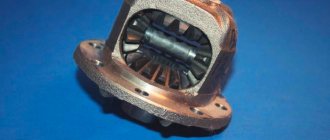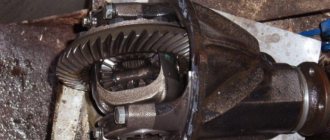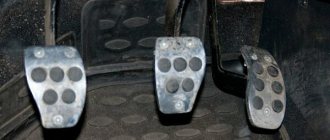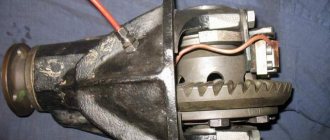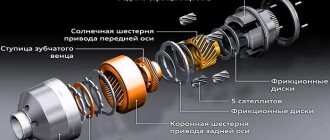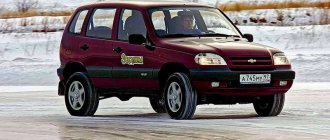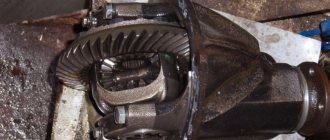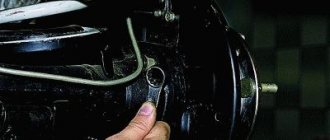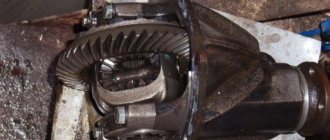Most new cars are equipped with a differential lock. Some of the older models also have this mechanism, but these are mainly SUVs and trucks. But today, every self-respecting manufacturer, for greater vehicle cross-country ability over rough terrain and in bad weather conditions, supplements the drive system with this mechanism.
As a rule, it is installed on the rear axle, but more and more often you can find cars with locking front and rear wheels. Electronic differential locking has become a fashion trend. The benefits of the system cannot be overestimated; it is not for nothing that many car enthusiasts install it on cars that were not originally equipped with the mechanism. To get excited about this idea, it is enough to experience the difference in driving with and without torque limitation. Or at least see how these cars will behave in difficult road conditions. But first, you should learn in more detail about what a differential lock is and what role it plays in the drive from the gearbox to the wheel axle.
WHAT IS DIFFERENTIAL
Not many drivers know that the right and left wheels travel different distances when driving. This phenomenon is due to the fact that when turning, the wheels rotate at different angles relative to the axle shaft. The outer one travels a greater distance when turning than the inner one. The differential distributes torque between both wheels depending on the movement of each of them. If one of the wheels for some reason stops turning, its load goes to the neighboring one.
The non-driving axles have no connection with each other, so the wheels rotate independently of each other. The axle shafts of the driving wheels are connected to each other. The drive is designed in such a way that one axle shaft and transmission can spin both wheels. On a flat road with good surface it is practically not felt. But on rough terrain, slippery or wet roads, the lack of a uniform torque distribution system makes itself known immediately. A non-locking differential rotates only the axle shaft that has the least resistance.
Roughly speaking, a differential is a unit unit that distributes torque to the wheels along the axle shafts.
DEVICE
The operating principle of the above-mentioned unit is the same, no matter where it is installed. The classic car differential is based on a planetary gear. The cardan shaft rotates the drive gear of the axle reducer. Its rotation is transmitted to the driven gear. And since it is attached to the differential housing, it moves with it. From the body, the torque is transmitted to the axle shafts using gears independent from each other, called satellites. The rotation speed of the propeller shaft is not equally divided between the axle shafts. However, for any ratio of speeds, their sum is always constant.
Types of blocking:
- automatic;
- forced, activated by the driver.
By blocking control method:
- mechanical;
- electromechanical;
- hydraulic;
- pneumatic
Why block him?
In certain situations this is necessary. To make it clearer, let's look at everything in order. If a car turns sharply or goes over rough terrain, its drive wheels travel different lengths. For example, when turning, the path of the outer wheel will be longer, and the path of the inner wheel will be shorter. Previously, when car speeds were low, this circumstance did not particularly worry anyone. But gradually the speed of the cars increased, and problems began to arise:
- tires wear unevenly;
- handling is seriously degraded.
All this happens due to the fact that the torque on the drive wheels of the car is always the same. Therefore, it became necessary to separate the drive wheels so that each of them had its own torque. This task is performed by the VAZ 2107 differential. If the road is smooth, there are no problems with this unit. But as soon as the car finds itself on rough terrain with the differential engaged, the wheels begin to slip, and driving the car becomes much more difficult. It is in this situation that the driver should lock the differential to increase the vehicle's maneuverability.
Explanation of operating principle
Translated from Latin, differentia means “difference.” In a car, a differential is a mechanism that distributes torque to the car axles. It definitely exists in every car. A simple differential is called classic, open or free.
Let's imagine that the rear axle gearbox does not have a differential, but there is a single axle, like a tricycle.
Since there is no absolutely linear movement, and the driver's hands almost never lie motionless on the steering wheel, it is clear that the path of the drive wheels will be very similar, but slightly different.
If there were no differential, then the path of the left and right wheels would be the same. Then constant slipping will become inevitable, since a common trajectory is “imposed” on the wheels. This results in increased tire wear and rapid failure of transmission units.
The task of the gearbox is to give the wheels independence and “freedom”, to separate their rigid connection.
How does a classic differential work?
If there is one drive axle (all VAZ classics), then one gearbox is required between the rear wheels, i.e. interwheel. In the case of a full-fledged jeep, there are as many as three differentials - two inter-wheel differentials for each axle, and an additional inter-axle one.
This mechanism (also called a gearbox) is installed in the rear axle housing. The drive gear transmits torque to the driven gear. It is distributed into two gears of the axle shafts, and they rotate the wheels.
Additional gears - satellites are a symmetrical equal-arm lever, and transmit forces equally to the wheels.
When the car moves in a straight line, the satellites do not rotate. As soon as the car slides onto uneven ground or enters a turn, that is, when each wheel has its own path, the satellites begin to rotate and redistribute the torque between the wheels of the drive axle, and to the axle shaft that has less resistance and is easier to spin.
The VAZ differential is shown in the figure below:
8 — axle gear; 9 — satellite; 11 — driven gear of the main gear; 18 — drive gear of the main gear;
This is how the satellites behave and distribute the moment of movement in different areas:
- linear movement
- left turn
— the right wheel is slipping
From the analysis of the rotational speeds of the axle shafts and gearbox it follows that:
- If one wheel is stationary, then the free wheel rotates “for two”, and the rotation speed is doubled.
- If one wheel slips, it spins faster and starts to slip, and the second wheel with good grip will receive the same torque, since it is distributed equally, and the differential cannot give it all the traction.
- If the traction of a single wheel becomes less than the resistance to movement, the car will stop.
- In this case, the situation of point 1 arises, the running wheel stops, and the previously slipping wheel sharply increases speed.
- When you try to “add gas,” the speed of the slipping wheel increases.
Types of blocking
There are three of them: manual (forced), automatic (self-locking differential) and partial.
- The driver turns on the manual locking himself when he finds himself on rough terrain. It's simple: a switch is pressed in the cabin, after which a special limiting unit begins to operate, preventing torque from being distributed to the drive wheels depending on the path they travel. The advantages of such a lock are obvious: the driver himself decides when to engage the limiting mechanism, and the rest of the time this device does not work and, accordingly, does not wear out. There are also disadvantages: to lock the differential manually, the driver will have to take his mind off the controls. And he gets distracted in extremely difficult road conditions. The driver should also not forget to disable the lock when he is on a flat road. If you don't do this, you can break the differential itself. And finally, you will have to install not only the limiter itself, but also the system that will operate it, which is associated with certain technical difficulties.
An example of forced differential locking on VAZ and Niva cars
An example of a finished lock on a VAZ from Val-racing
Self-locking differential
This is something between the simplest hard locking system and an independent differential. The simplest self-locking differential is a disc. It is the same free mechanism, but with friction discs on any axle shaft, operating like a clutch. This mechanism is good in that it allows you to regulate the pressing force of the clutches, and as a consequence, the distribution of torque between the drive wheels. The pressing force can be either fixed or adjustable by a pneumatic drive, hydraulics or electronics. Such differentials are used in axles of sports cars and as center differentials in some SUVs, the previous generation Nissan Patrol, for example.
A viscous coupling, or viscous coupling, is a kind of torque converter. This is a set of disks that are located close to each other and are in one case filled with silicone liquid. This liquid tends to harden as the temperature rises, which is what happens when some disks begin to rotate faster and others slower. As soon as the wheels begin to equalize angular speeds, the fluid cools and the viscous coupling is unblocked.
Video: differential lock
There are also electronic differential locking systems, but in fact, this is just an imitation, since the brakes act as a mechanism compensating angular speeds, not the transmission, and the system is triggered by a signal from sensors. There are quite a few of these systems, but the most famous are the EDS in most cars (Nissan Pathfinder, Renault Duster), or the ETS system in Mercedes cars. Volkswagen installs more advanced systems, ETS with advanced functions, XDS. These complexes are installed on Skoda Octavia, Volkswagen Passat, Tiguan. Electronic systems cannot be considered as differential locks, but only as a means of increasing safety.
Share link:
- Click to share on Twitter (Opens in new window)
- Click here to share content on Facebook. (Opens in a new window)
Which one to choose for VAZ 2107
The answer to this question directly depends on the operating conditions of the vehicle. If the car owner never goes into the city and moves exclusively on country roads and rough terrain, a full manual differential lock is suitable for him. If the driver drives around the city, but the quality of the roads there leaves much to be desired, it makes sense to opt for automatic disc locking. Finally, if a car owner drives on good city roads all year round, a partial differential lock mechanism is quite suitable for him. The best devices of this type are produced by Quaife, Lokka and Torsen. These are expensive components, the installation of which is best left to qualified specialists. At the same time, you can do simple blocking yourself. This is exactly what will be discussed below.
Sequencing
- Before starting work, 2 bushings are made from bronze or brass according to the drawing given below.
Locking brass bushing for VAZ 2107 gearbox
A pair of bushings in a spring from a valve of a VAZ 2110 car
Axle shaft removed from VAZ 2107
Standard gearbox removed from a VAZ 2107
A pair of bushings is inserted into the VAZ 2107 gearbox
Video: Installing a lock on seven with your own hands
To summarize, it should be said that differential locking on the VAZ 2107 was and remains a very controversial issue. On the one hand, the car's cross-country ability increases, it corners better, and acceleration becomes more dynamic. On the other hand, it is not so easy to keep an accelerated car on a straight line, and its tendency to skid increases. In a word, whether to install it or not is up to the driver to decide.
How to set preload
Preload adjustment is carried out by installing a package of special spring washers that push the gears inside the lock. A complete package of such special washers, folded all together, is 1 cm thick, but all the washers are different in thickness so that the torque can be adjusted.
To adjust the preload you will need:
- pointer torque wrench (a wrench with clicks is not suitable, it will take a long time to set up);
- a homemade special part made from a simple internal grenade (cut off and a bolt welded to it) - see the video below;
- set of spring washers (rings);
Procedure for adjusting preload:
- Disassemble the locking differential (remember the sequence). After removing the cover, pull out the axle shaft auger gear; behind it comes a narrow gear with a large internal hole, but which has a side; then come those same adjusting spring washers. You can pull out the screw satellites (the preloads themselves) to check how much wear they have.
- Install new washers.
- Collect.
- Using a torque wrench and a special homemade part, we determine the tightening torque. When the key begins to turn, at this moment the arrow shows the tension torque.
This video discusses the option of adjusting the locking washers of a VAZ 2108 car.
A preload of up to 5 kg does not flatten the washer to a flat state; such a tension moment is considered a resource tension. Locking with a tension of up to 5 kg will help not significantly lose its characteristics for about 4 years. Any blocking with tension in the first couple of months loses about 1 kg of tension.
Experts recommend making a preload of no more than 5 kg for a self-locking front differential, and no more than 7 kg for a rear differential. At a maximum value of, for example, 9 kg, all spring washers will already be pressed and the effect of the springs will be lost.
In short, this is a multi-stage gearbox. Through it, torque from the engine is transmitted to the drive wheels. It can be open, semi-open and closed.
Rear gear differential spool VAZ 2101, 2102, 2103, 2104, 2105, 2106, 2107
A hard differential lock of the spool type is used on VAZ 2101-2107 sports cars for participation in drifting and rally competitions.
Spool is the most reliable and simple solution for transmitting the same torque to both wheels of the rear axle of the car, which allows you to constantly keep the car in a controlled skid, as well as increase the stability and acceleration dynamics in a straight line.
Installing a spool differential allows you to avoid handicraft methods for solving the problem of completely blocking the differential, such as welding, which in turn is not reliable and is prone to breakdown.
Thanks to its relatively simple design, this type of differential is easy to install and does not require special maintenance.
The spool for VAZ 2101-2107 is produced in the factory using imported equipment, taking into account high manufacturing precision.
In warehouse in Samara
Self-locking system
Can be configured to the required switching threshold. This can be either a slight slip or uneven distribution of torque among the wheels. Such a connection is not rigid, and therefore does not place unnecessary load on the interaxial connection.
When installing a forced locking system on a Chevrolet Niva, you should remember that a constantly turned on system can put unnecessary stress on the transmission, so you should turn it on only when overcoming difficult sections of the road.
